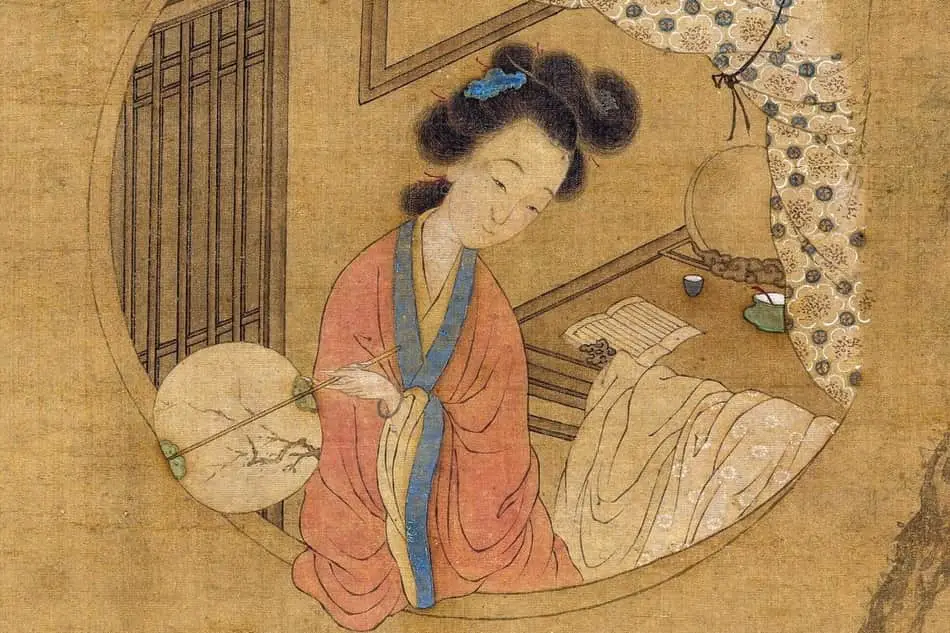The tai chi fan is relatively a new-comer to the tai chi weapons forms but there are many reasons to consider adding it to your tai chi practice. It’s light, small, inexpensive, fun, and can improve your other tai chi forms in really unique ways.
The tai chi fan is a Chinese martial arts weapon form that teaches connected movements, hidden intent, deception, and dexterity with fine hand motions. The fan forms are unique for adding elements of surprise with their brilliant displays of color and loud popping noises made when the fan opens.
In order to get the most out your fan practice, there are five techniques that will help you move the fan gracefully in both hands and ways to open and close the fan quickly. Let’s start there and then get to the good stuff and show championship examples of the fan form as well as tai chi fan dance competitions.

Tai Chi Fan History and Mystery
Truth-be-told, there isn’t a lot to tai chi fan history for the Chinese marital arts because it wasn’t used by the military like the other weapons. In Japanese martial arts however, the fan is used by some styles and are even outfitted with metal blades. Possibly during warring and occupations between the two countries in the 1800-1900s, the idea of the fan as part of the Chinese martial tradition was introduced. Modern fans are really well designed with the folding part being strong synthetic material and the tines being made of wood, plastic or metal.
Fans have been part of Chinese society for hundreds of years. It began as you would expect as a way to cool down and shoo away insects. Fans then became social status symbols and were decorated with art being carried out in society. It is at this point that they began to be used to hide a women’s facial expression and hide intent. Between the colorful display when they were opened and the obscuring or hiding of intentions, we begin to see how they made their way into the Chinese martial arts to express surprise and deception.
The fan form teaches and practices graceful movements, hidden intent, mystery, deception, and surprise. More than the other weapons, it also focuses on finely articulated hand movements which really help the open-hand forms to look better because students who practice with the fan put more intention into how their hands move in all the other forms.
Only Chen style and Yang style have a true tai chi fan history of practice while there are some smaller schools that also have it as part of their tradition. Tai chi fan forms exist with 18, 24, 52, and 56 movements being the most common. The tai chi fan Yang Style 18 might be the most popular probably due to Yang’s popularity and 18 moves being easier to teach and learn. There are also double fan tai chi forms but those are even more rare.
The important thing to remember and think about when doing the fan form is to keep it light-hearted. It’s beautiful, fun, and less intimidating than the other weapons. Some people point to the fan as an example of why tai chi has lost its reputation for being a fighting art but I feel they are missing the beauty of it and not seeing how proper fan use actually demonstrates good internal energy skills. It is also a great weapon form for tai chi beginners because it is small and not intimidating.
5 Techniques to Open a Tai Chi Fan Faster with Left and Right Hands
The coolest aspect of the tai chi fan is that amazing popping sound it makes when opened correctly. It’s shocking because this instantaneous loud noise is juxtaposed against a smooth quiet form. And at the same time, there is a bloom of color or two if you are doing the double tai chi fan form. Like everything tai chi related, it’s not as easy as it seems! Here are some pointers to get you opening the tai chi fan faster and also get it closed back up as you proceed through the form.
- Begin by practicing the downward motion until it is fast and loud. Then translate these movements into practicing with the fan moving towards you and horizontally.
- Do tai chi fan drills. Practice opening and closing the fan in drills outside of the form when you can concentrate on it exclusively. There are three general directions: down, up, and horizontal. Open and close in each direction nine times with each hand.
- Keep the end of the fan in the center of the palm. The fan rests in the palm throughout most of the form. Get into this habit early.
- Move the entire body. While the fan looks like it is just a flick of the wrist, power initiates from the feet and whips the body ending with the snapping sound of the fan.
- Make your fan open and close faster by holding it on an angle. If you begin and end your movement with the fan at a 30-5 degree angle you will dramatically increase the speed. Trying to stop or start the fan from a vertical position reduces the speed your wrist can twist at.
Opening and Closing the Fan with the Right Hand
- Hold the fan so that base is in the center of the palm.
- Grab the top tine with your thumb and pointer finger. You are holding the correct tine if the fan falls open.
- Flick the wrist to the left to open the fan to get the snapping sound.
- Pinch the fingers against the tines when it is fully open so you don’t drop it.
- Close the fan by releasing the lower finger and snapping the wrist back the other direction.
- Do not try to stop the fan vertically. To close it properly you will end with the fan at a right angle (unless your style stops vertically).
Opening and Closing the Fan with the Left Hand
While there are left-handed fans, in many tai chi fan forms you trade the fan from one hand to the other so you need to learn the fan techniques in both hands using a right handed fan. If you hold the fan the same way as you did with the right hand, the fan won’t open.
- Position the end of the fan in your palm.
- Grab the lowest tine with the thumb and pointer finger instead of the top tine like on the right side. The pointer finger has to do more work on this side.
- Push with the side of the thumb to get the fan moving open.
- Pull back with the lower finger to begin to close it
- Again, it is easier to close if you go past vertical with the top of the fan pointing off at an angle
Best Tai Chi Fan Video Examples
We have been talking about how beautiful the fan is so let’s jump in with two amazing examples. Sometimes when examples are amazing, we totally get motivated to practice. This video is one of the best tai chi fan examples I could find Check out the continual movement, squareness of the knee and hip joints when she sits in her stance, and just how much fun she seems to be having.
Okay, I have to show you one more. We can’t have a best tai chi fan conversation without showing you a conference champion can we? Check out posture, openness of chest, and continual movement of Taiji Champion Zhang Li during the 35th All Japan Wushu Taiji Championships.
Chen Tai Chi Fan 24 Form
Chen style is one of the two main styles that practice the fan. The Chen tai chi fan 24 form is probably the most popular. Know that many Chen tai chi schools don’t practice the fan. It is not a statement against the fan, it’s just not part of their curriculum. What is unique to Chen style is also unique to the Chen style tai chi fan form. Lower posters are more common, lower postures are held for longer, and there are progressions from one low posture to another without rising up.
Some people believe that Chen style is less graceful. I would say that there is some truth there but I think it is better described as prioritizing power and function in each movement rather than adding extra circles or weight shifts to make things look better. Chen is also know for explosive “fa-jing” movements which are really impressive. In this Chen style tai chi fan 24 form you can see many of them.
Tai Chi Fan Dance
Many people consider the fan to be a dance or performance rather than a martial form. I want to separate the forms from tai chi fan dance routines. They are beautifully choreographed routines that are based on martial movements and movements from the form. They are often adaptations of forms that are put together for competitions and special events. What I love about tai chi fan dance is that it really demonstrates a high art form and I almost wish the other weapons would be modified and played around with more often. Tai chi weapons are just too beautiful and too fun to remain in their old, stodgy forms all the time. Here is a dance put together by the Fujian Wushu Team. Check out the timing on the opening and closing of the fans. Super cool.
Want to get started? There are a lot of great fans that are not expensive but there are a couple of things you will want to know about the different types and how many you want to buy. We wrote about it on our weapons page.


